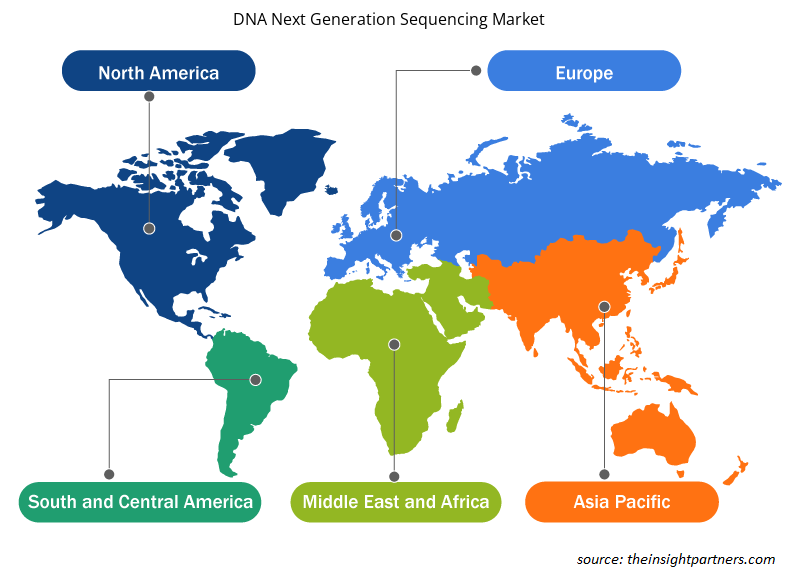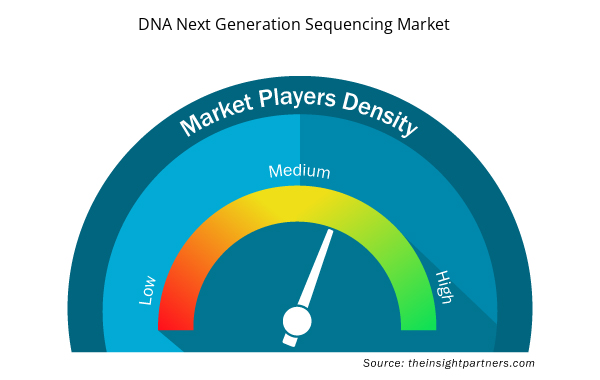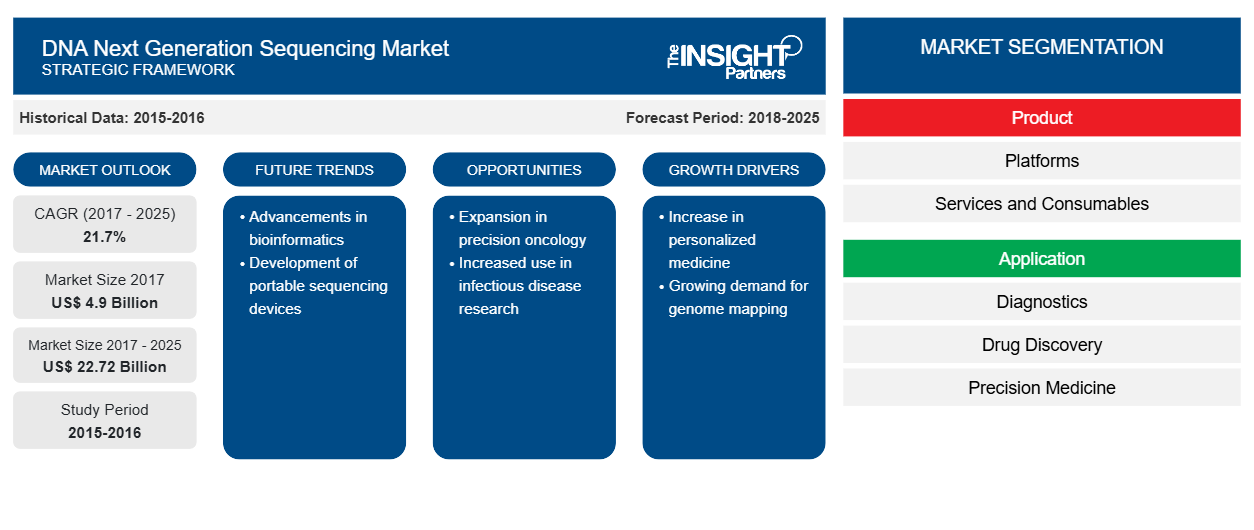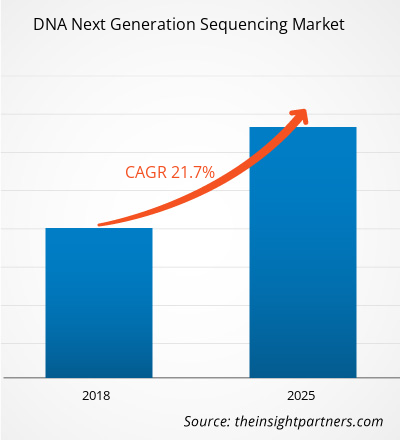[تقرير بحثي] من المتوقع أن يصل حجم سوق تسلسل الجيل التالي للحمض النووي إلى 22،716.9 مليون دولار أمريكي بحلول عام 2025 من 4،898.5 مليون دولار أمريكي في عام 2017؛ ومن المتوقع أن ينمو بمعدل نمو سنوي مركب قدره 21.7٪ خلال الفترة 2018-2025.
يُعرف التسلسل الجيني للجيل التالي أيضًا بالتسلسل عالي الإنتاجية. يتيح NGS التسلسل السريع للأزواج القاعدية في عينات الحمض النووي. يقود NGS تطبيق اكتشاف الأدوية وتمكين مستقبل الطب الشخصي والأمراض الوراثية والتشخيصات السريرية. علاوة على ذلك، فإن التسلسل الجيني للجيل التالي ( NGS ) هو تقنية تسلسل موازية للغاية يمكنها تحديد ترتيب النوكليوتيدات في الجينوم بأكمله مع إمكانية التوسع والإنتاجية العالية للغاية والسرعة العالية. نظرًا لأنه يتضمن تحضير العينة لتفاعل التسلسل اللاحق، فإن التسلسل المسبق للحمض النووي هو أحد أهم العمليات في بروتوكول التسلسل الإجمالي. في قطاع الرعاية الصحية العالمي، يتم دمج NGS بشكل مطرد في التحليل المختبري السريري والاختبار وتشخيص الأمراض. في علم الصيدلة الجينية ، تم استخدام NGS على نطاق واسع لتسريع عملية اكتشاف الأدوية.
يعود نمو سوق تسلسل الحمض النووي من الجيل التالي إلى زيادة عدد حالات الإصابة بالسرطان في جميع أنحاء العالم، وارتفاع الدراسات البحثية، وزيادة التعاون بين معاهد البحث والجهات الفاعلة في السوق جنبًا إلى جنب مع زيادة تطبيقات تسلسل الحمض النووي من الجيل التالي والتقدم التكنولوجي في تقنيات التسلسل. ومع ذلك، من المتوقع أن يؤثر ندرة المهنيين المهرة بشكل حاسم على نمو سوق تسلسل الحمض النووي من الجيل التالي بشكل عام.
قم بتخصيص هذا التقرير ليناسب متطلباتك
ستحصل على تخصيص لأي تقرير - مجانًا - بما في ذلك أجزاء من هذا التقرير، أو تحليل على مستوى الدولة، وحزمة بيانات Excel، بالإضافة إلى الاستفادة من العروض والخصومات الرائعة للشركات الناشئة والجامعات
- احصل على أهم اتجاهات السوق الرئيسية لهذا التقرير.ستتضمن هذه العينة المجانية تحليلاً للبيانات، بدءًا من اتجاهات السوق وحتى التقديرات والتوقعات.
رؤى السوق
انخفاض أسعار التسلسل والتقدم التكنولوجي في أساليب التسلسل يدفع سوق تسلسل الحمض النووي من الجيل التالي
في السنوات الأخيرة، انخفضت أسعار تسلسل الجيل التالي بشكل كبير. في عام 2000، بلغت تكلفة تسلسل الجينوم البشري 3.7 مليار دولار أمريكي واستغرق إكماله 13 عامًا. ومع ذلك، انخفضت تكاليف نفس الشيء في السنوات الأخيرة إلى 10 ملايين دولار أمريكي في عام 2006 وانخفضت أكثر في عام 2012، وتتطلب العملية أيامًا أقل. قدم كبار اللاعبين في سوق تسلسل الجيل التالي للحمض النووي مثل Illumina وRoche تقنيات رائدة فعالة من حيث التكلفة وتتطلب وقتًا أقل في عمليات التسلسل.
علاوة على ذلك، أدى التقدم في مجال البيولوجيا الجزيئية إلى تعزيز إجراءات التسلسل بنفس القدر. وقد توصل العديد من اللاعبين في الصناعة إلى تقنية تسلسل الجيل التالي المبتكرة في السنوات القليلة الماضية. على سبيل المثال، شركة Pacific Biosciences مع Sequel وشركة Oxford Nanopore مع PromethION . بالإضافة إلى ذلك، تشمل ثلاثة أنظمة NSG متقدمة تهيمن على السوق Roche GS FLX (454) و Illumina HiSeq 2000 ( Solexa ) و AB SOLiD ( Agencourt ).
وقد أدى المزيد من التعديل والأتمتة لهذه العملية إلى زيادة بيانات التسلسل، كما أدى إلى إدارة الوقت بكفاءة أكبر، مما سمح للباحثين بالوصول إلى معالم رئيسية في مشروع الجينوم البشري. يجعل NGS تحليل التعبير الجيني القائم على التسلسل بديلاً "رقميًا" للتقنيات التناظرية. لقد جعل التقدم في تسلسل الجينوم التسلسل سهلاً ودقيقًا. ومن المرجح أن تعزز هذه التطورات التكنولوجية حجم سوق تسلسل الحمض النووي للجيل القادم في المستقبل القريب.
رؤى قائمة على المنتج
تم تقسيم سوق تسلسل الجيل القادم للحمض النووي العالمي، استنادًا إلى المنتج، إلى منصات وخدمات ومواد استهلاكية. تم تقسيم شريحة المنصة إلى سلسلة HiSeq وسلسلة MiSeq وSOLiD وIon Torrent وPacbio Rs II وSequel Systems وغيرها. علاوة على ذلك، تم تقسيم شريحة الخدمات إلى خدمات التسلسل وخدمات إدارة وتحليل البيانات. علاوة على ذلك، تم تقسيم شريحة المواد الاستهلاكية إلى تحضير المواد الاستهلاكية للعينات ومواد استهلاكية أخرى لـ NGS. احتلت شريحة المواد الاستهلاكية حصة أكبر بين شرائح المنتجات الفرعية في سوق تسلسل الجيل القادم للحمض النووي في عام 2017 ومن المتوقع أيضًا أن تتبع اتجاهًا مشابهًا خلال فترة التنبؤ. تبنت منصات NGS الأحدث طريقة تسلسل جديدة تسمى تسلسل الجزيء الفردي (SMS)، والتي لا تتطلب تضخيمًا مسبقًا للحمض النووي، وبالتالي تجنب قراءات الخطأ المرتبطة بتفاعل البوليميراز المتسلسل أو تحيز التضخيم تجاه مناطق التكرار. خلال السنوات الخمس الماضية، انتقلت تقنية التسلسل الجيني للجيل التالي من البحث إلى الاستخدام السريري. فقد أطلقت 14 دولة على الأقل مبادرات لتسلسل أعداد كبيرة من السكان، ومن المتوقع أن يتم تسلسل جينوم أكثر من 60 مليون شخص في جميع أنحاء العالم بحلول عام 2025.
رؤى قائمة على التطبيق
يتم تقسيم سوق تسلسل الجيل التالي العالمي للحمض النووي، بناءً على التطبيق، إلى التشخيص واكتشاف الأدوية والطب الدقيق وتطبيقات أخرى. احتل قطاع التشخيص الحصة الأكبر في عام 2017 ومن المتوقع أن يشهد نموًا كبيرًا على مدى السنوات الخمس إلى الست القادمة. يتطلب استخدام تقنية تسلسل الجيل التالي (NGS) في رعاية الجينوم التشخيصي الدقة والضبط. تستخدم تقنيات NGS التسلسل الفعال من حيث التكلفة للحصول على معلومات جينومية عن المرضى من تسلسل الجينوم الكامل لأداء الإجراءات السريرية. يحل تسلسل الجيل التالي في النهاية محل التقنيات التقليدية لتشخيص الاضطرابات الوراثية المختلفة. يمكن الآن معالجة مجموعات كبيرة من الجينات في اختبار واحد بدلاً من نهج الجين حسب الجين.
رؤى تعتمد على المستخدم النهائي
السوق العالمية، بناءً على المستخدم النهائي، مقسمة إلى معاهد أكاديمية وبحثية وشركات أدوية وتكنولوجيا حيوية ومستشفيات وعيادات ومستخدمين نهائيين آخرين. ومن المتوقع أن يشهد قطاع المعاهد الأكاديمية والبحثية أعلى نمو خلال فترة التنبؤ. يساعد التسلسل العلماء في العثور على نوع المعلومات الجينية التي يحملها جزء معين من الحمض النووي. على سبيل المثال، يمكن للعلماء استخدام معلومات التسلسل لتحديد أجزاء الحمض النووي التي تحتوي على جينات وأي أجزاء تحمل تعليمات تنظيمية، وتشغيل الجينات أو إيقاف تشغيلها. تم تقديم النهج الصناعي الآلي القائم على التسلسل العشوائي أو العشوائي من قبل معهد أبحاث الجينوم (TIGR) في روكفيل بولاية ماريلاند، وأسفر عن نشر 337 جينًا بشريًا جديدًا و48 جينًا متماثلًا من كائنات حية أخرى
رؤى إقليمية حول سوق تسلسل الحمض النووي للجيل القادم
لقد قام المحللون في Insight Partners بشرح الاتجاهات والعوامل الإقليمية المؤثرة على سوق تسلسل الجيل التالي للحمض النووي طوال فترة التوقعات بشكل شامل. يناقش هذا القسم أيضًا قطاعات سوق تسلسل الجيل التالي للحمض النووي والجغرافيا في جميع أنحاء أمريكا الشمالية وأوروبا ومنطقة آسيا والمحيط الهادئ والشرق الأوسط وأفريقيا وأمريكا الجنوبية والوسطى.

- احصل على البيانات الإقليمية المحددة لسوق تسلسل الجيل التالي للحمض النووي
نطاق تقرير سوق تسلسل الجيل التالي من الحمض النووي
| سمة التقرير | تفاصيل |
|---|---|
| حجم السوق في عام 2017 | 4.9 مليار دولار أمريكي |
| حجم السوق بحلول عام 2025 | 22.72 مليار دولار أمريكي |
| معدل النمو السنوي المركب العالمي (2017 - 2025) | 21.7% |
| البيانات التاريخية | 2015-2016 |
| فترة التنبؤ | 2018-2025 |
| القطاعات المغطاة | حسب المنتج
|
| المناطق والدول المغطاة | أمريكا الشمالية
|
| قادة السوق وملفات تعريف الشركات الرئيسية |
|
كثافة اللاعبين في السوق: فهم تأثيرها على ديناميكيات الأعمال
يشهد سوق تسلسل الحمض النووي للجيل القادم نموًا سريعًا، مدفوعًا بالطلب المتزايد من المستخدم النهائي بسبب عوامل مثل تفضيلات المستهلك المتطورة والتقدم التكنولوجي والوعي المتزايد بفوائد المنتج. ومع ارتفاع الطلب، تعمل الشركات على توسيع عروضها والابتكار لتلبية احتياجات المستهلكين والاستفادة من الاتجاهات الناشئة، مما يؤدي إلى زيادة نمو السوق.
تشير كثافة اللاعبين في السوق إلى توزيع الشركات أو المؤسسات العاملة في سوق أو صناعة معينة. وهي تشير إلى عدد المنافسين (اللاعبين في السوق) الموجودين في مساحة سوق معينة نسبة إلى حجمها أو قيمتها السوقية الإجمالية.
الشركات الرئيسية العاملة في سوق تسلسل الجيل التالي للحمض النووي هي:
- شركة إيلومينا
- ثيرمو فيشر
- كياجن إن في
- معهد بكين لعلم الجينوم
- شركة بيركين إلمر
إخلاء المسؤولية : الشركات المذكورة أعلاه ليست مرتبة بأي ترتيب معين.

- احصل على نظرة عامة على أهم اللاعبين الرئيسيين في سوق تسلسل الجيل التالي للحمض النووي
إن إطلاق المنتجات والموافقة عليها هي استراتيجيات تتبناها الشركات عادة لتوسيع بصماتها العالمية ومحافظ منتجاتها. وعلاوة على ذلك، يركز اللاعبون في السوق على استراتيجية الشراكة لتوسيع قاعدة عملائهم، الأمر الذي يسمح لهم بدوره بالحفاظ على اسم علامتهم التجارية في جميع أنحاء العالم. ومن المتوقع أن تزدهر حصة السوق مع تطوير منتجات مبتكرة جديدة من قبل اللاعبين في السوق. ومن بين المشاركين في السوق الحاضرين في السوق المعنية شركة THERMO FISHER SCIENTIFIC INC.؛ وشركة Illumina، وشركة Qiagen NV؛ وشركة Beijing Genomics Institute؛ وشركة PerkinElmer، وشركة F.Hoffman-La Roche Ltd.؛ وشركة Agilent Technologies؛ وشركة Eurofins Scientific؛ وشركة Oxford Nanopore Technologies Ltd؛ وشركة Macrogen Inc.
- التحليل التاريخي (سنتان)، السنة الأساسية، التوقعات (7 سنوات) مع معدل النمو السنوي المركب
- تحليل PEST و SWOT
- حجم السوق والقيمة / الحجم - عالميًا وإقليميًا وقطريًا
- الصناعة والمنافسة
- مجموعة بيانات Excel



Report Coverage
Revenue forecast, Company Analysis, Industry landscape, Growth factors, and Trends

Segment Covered
This text is related
to segments covered.

Regional Scope
North America, Europe, Asia Pacific, Middle East & Africa, South & Central America

Country Scope
This text is related
to country scope.
الأسئلة الشائعة
The DNA next generation sequencing market is growing at CAGR of 21.7% from 2018-2025.
Major market players such as Illumina and Roche have introduced breakthrough technologies that have enabled in the cost and time reduction in the sequencing.
As per forecast report, the market value of DNA next generation sequencing market in 2025 will be US$ 22,716.9 Million.
The growth of the global DNA next generation sequencing market is attributed to the increases in cancer prevalence, technological development and decreasing price of sequencing. Owing to factors like advances within the field of genetic science, development in several ways and methods for sequencing, there's a notable decline within the price of sequencing.
The List of Companies
1. Illumina, Inc.
2. Thermo Fisher
3. Qiagen N.V.
4. Beijing Genomics Institute
5. PerkinElmer, Inc.
6. Hoffman-La Roche Ltd.
7. Agilent Technologies
8. Eurofins Scientific
9. Oxford Nanopore Technologies Ltd.
10. Macrogen Inc.
The Insight Partners performs research in 4 major stages: Data Collection & Secondary Research, Primary Research, Data Analysis and Data Triangulation & Final Review.
- Data Collection and Secondary Research:
As a market research and consulting firm operating from a decade, we have published and advised several client across the globe. First step for any study will start with an assessment of currently available data and insights from existing reports. Further, historical and current market information is collected from Investor Presentations, Annual Reports, SEC Filings, etc., and other information related to company’s performance and market positioning are gathered from Paid Databases (Factiva, Hoovers, and Reuters) and various other publications available in public domain.
Several associations trade associates, technical forums, institutes, societies and organization are accessed to gain technical as well as market related insights through their publications such as research papers, blogs and press releases related to the studies are referred to get cues about the market. Further, white papers, journals, magazines, and other news articles published in last 3 years are scrutinized and analyzed to understand the current market trends.
- Primary Research:
The primarily interview analysis comprise of data obtained from industry participants interview and answers to survey questions gathered by in-house primary team.
For primary research, interviews are conducted with industry experts/CEOs/Marketing Managers/VPs/Subject Matter Experts from both demand and supply side to get a 360-degree view of the market. The primary team conducts several interviews based on the complexity of the markets to understand the various market trends and dynamics which makes research more credible and precise.
A typical research interview fulfils the following functions:
- Provides first-hand information on the market size, market trends, growth trends, competitive landscape, and outlook
- Validates and strengthens in-house secondary research findings
- Develops the analysis team’s expertise and market understanding
Primary research involves email interactions and telephone interviews for each market, category, segment, and sub-segment across geographies. The participants who typically take part in such a process include, but are not limited to:
- Industry participants: VPs, business development managers, market intelligence managers and national sales managers
- Outside experts: Valuation experts, research analysts and key opinion leaders specializing in the electronics and semiconductor industry.
Below is the breakup of our primary respondents by company, designation, and region:

Once we receive the confirmation from primary research sources or primary respondents, we finalize the base year market estimation and forecast the data as per the macroeconomic and microeconomic factors assessed during data collection.
- Data Analysis:
Once data is validated through both secondary as well as primary respondents, we finalize the market estimations by hypothesis formulation and factor analysis at regional and country level.
- Macro-Economic Factor Analysis:
We analyse macroeconomic indicators such the gross domestic product (GDP), increase in the demand for goods and services across industries, technological advancement, regional economic growth, governmental policies, the influence of COVID-19, PEST analysis, and other aspects. This analysis aids in setting benchmarks for various nations/regions and approximating market splits. Additionally, the general trend of the aforementioned components aid in determining the market's development possibilities.
- Country Level Data:
Various factors that are especially aligned to the country are taken into account to determine the market size for a certain area and country, including the presence of vendors, such as headquarters and offices, the country's GDP, demand patterns, and industry growth. To comprehend the market dynamics for the nation, a number of growth variables, inhibitors, application areas, and current market trends are researched. The aforementioned elements aid in determining the country's overall market's growth potential.
- Company Profile:
The “Table of Contents” is formulated by listing and analyzing more than 25 - 30 companies operating in the market ecosystem across geographies. However, we profile only 10 companies as a standard practice in our syndicate reports. These 10 companies comprise leading, emerging, and regional players. Nonetheless, our analysis is not restricted to the 10 listed companies, we also analyze other companies present in the market to develop a holistic view and understand the prevailing trends. The “Company Profiles” section in the report covers key facts, business description, products & services, financial information, SWOT analysis, and key developments. The financial information presented is extracted from the annual reports and official documents of the publicly listed companies. Upon collecting the information for the sections of respective companies, we verify them via various primary sources and then compile the data in respective company profiles. The company level information helps us in deriving the base number as well as in forecasting the market size.
- Developing Base Number:
Aggregation of sales statistics (2020-2022) and macro-economic factor, and other secondary and primary research insights are utilized to arrive at base number and related market shares for 2022. The data gaps are identified in this step and relevant market data is analyzed, collected from paid primary interviews or databases. On finalizing the base year market size, forecasts are developed on the basis of macro-economic, industry and market growth factors and company level analysis.
- Data Triangulation and Final Review:
The market findings and base year market size calculations are validated from supply as well as demand side. Demand side validations are based on macro-economic factor analysis and benchmarks for respective regions and countries. In case of supply side validations, revenues of major companies are estimated (in case not available) based on industry benchmark, approximate number of employees, product portfolio, and primary interviews revenues are gathered. Further revenue from target product/service segment is assessed to avoid overshooting of market statistics. In case of heavy deviations between supply and demand side values, all thes steps are repeated to achieve synchronization.
We follow an iterative model, wherein we share our research findings with Subject Matter Experts (SME’s) and Key Opinion Leaders (KOLs) until consensus view of the market is not formulated – this model negates any drastic deviation in the opinions of experts. Only validated and universally acceptable research findings are quoted in our reports.
We have important check points that we use to validate our research findings – which we call – data triangulation, where we validate the information, we generate from secondary sources with primary interviews and then we re-validate with our internal data bases and Subject matter experts. This comprehensive model enables us to deliver high quality, reliable data in shortest possible time.


 احصل على عينة مجانية لهذا التقرير
احصل على عينة مجانية لهذا التقرير